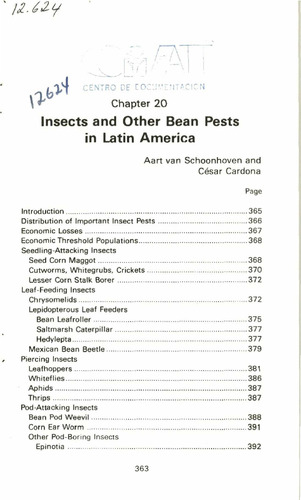Insects and other bean pest in Latin America
Abstract
Pests may affect bean production, before and after harvest. (1) Those that attack bean seedlings are the seed corn maggot which causes poor germination and deformed seedlings. The most common genera of cutworms include Agrotis, Feltia and Spodoptera; white grubs and crickets also attack the seedlings. (2) Leaf-feeding insects: many species of chrysomelids attack beans. These are also the vectors of BRMV. Several species of Lepidoptera develop on beans, among them the bean leaftoller, the saltmarsh caterpillar and Hedylepta indicata. The Mexican bean beetle is a pest found in many countries. (3) Piercing insects: leafhoppers are the most important pests. Different cultural practices can be used to reduce populations and damage. The planting of beans/maize in association reduces populations. Five species of Aleyrodidae (among them Bemisia tabaci a vector of BGMV and bean chlorotic mottle) live on beans, but they also have other host plants. (4) Pod-attacking insects: bean pod weevil whose chemical control is conducted 6 days after initiation of flowering; the corn ear worm; podborers. (5) Storage insects: the principal pests are Acanthoscelides obtectus and Zabrotes subfaciatus. Weevils can be controled by applying ashes, black pepper, inert dusts, vegetable oils or by chemical control, (6) Spider mites and tropical mites can develop resistance to pesticides. (7) Slugs are not insects but can be serious pests; species are Vaginulus plebeius, Limax maximus and Deroceras agreste. Best control is obtained by cleaning weeds and plant debris; baits can also be used. The principal pests in L.A. are presented in table form; there are color ilustrations of the insects and the type of crop damage. (CIAT)

